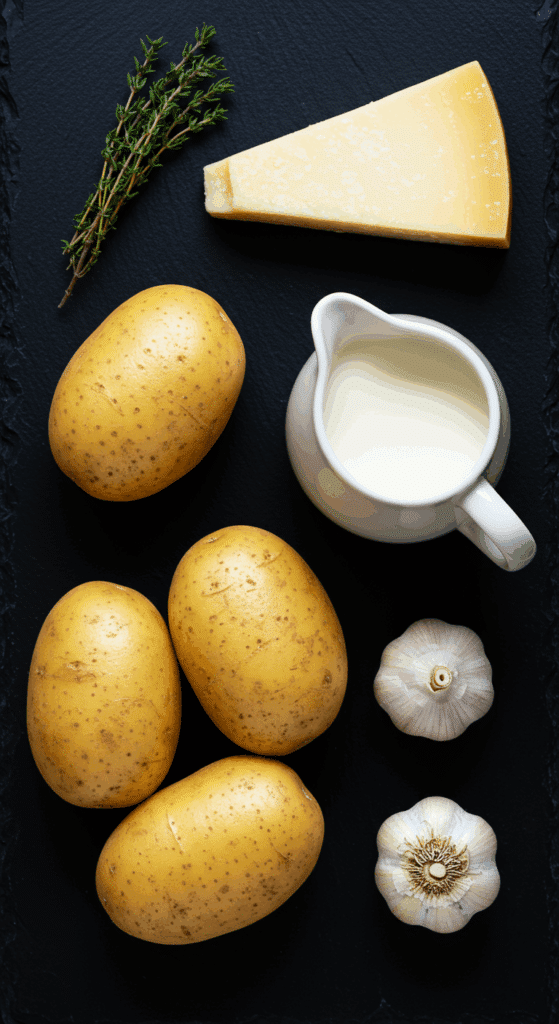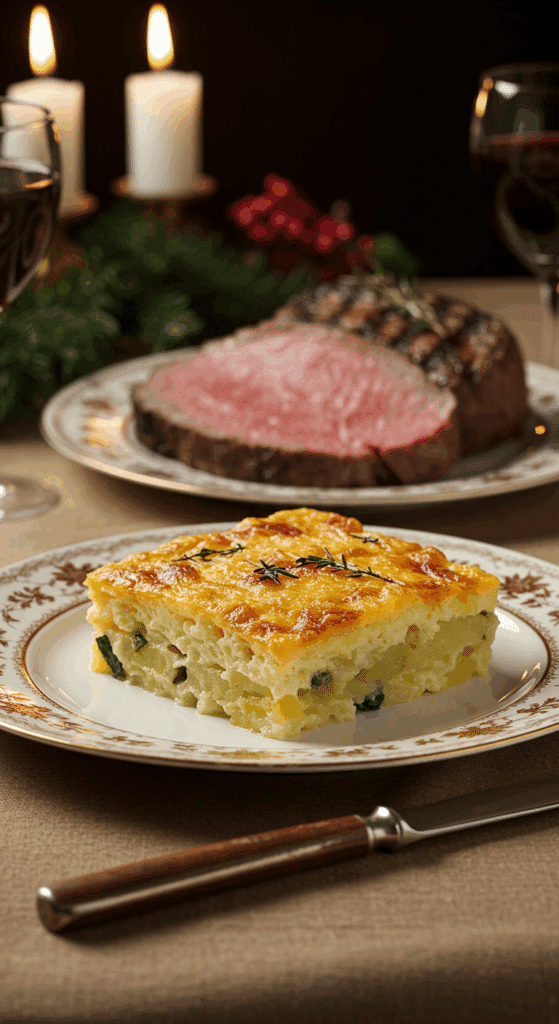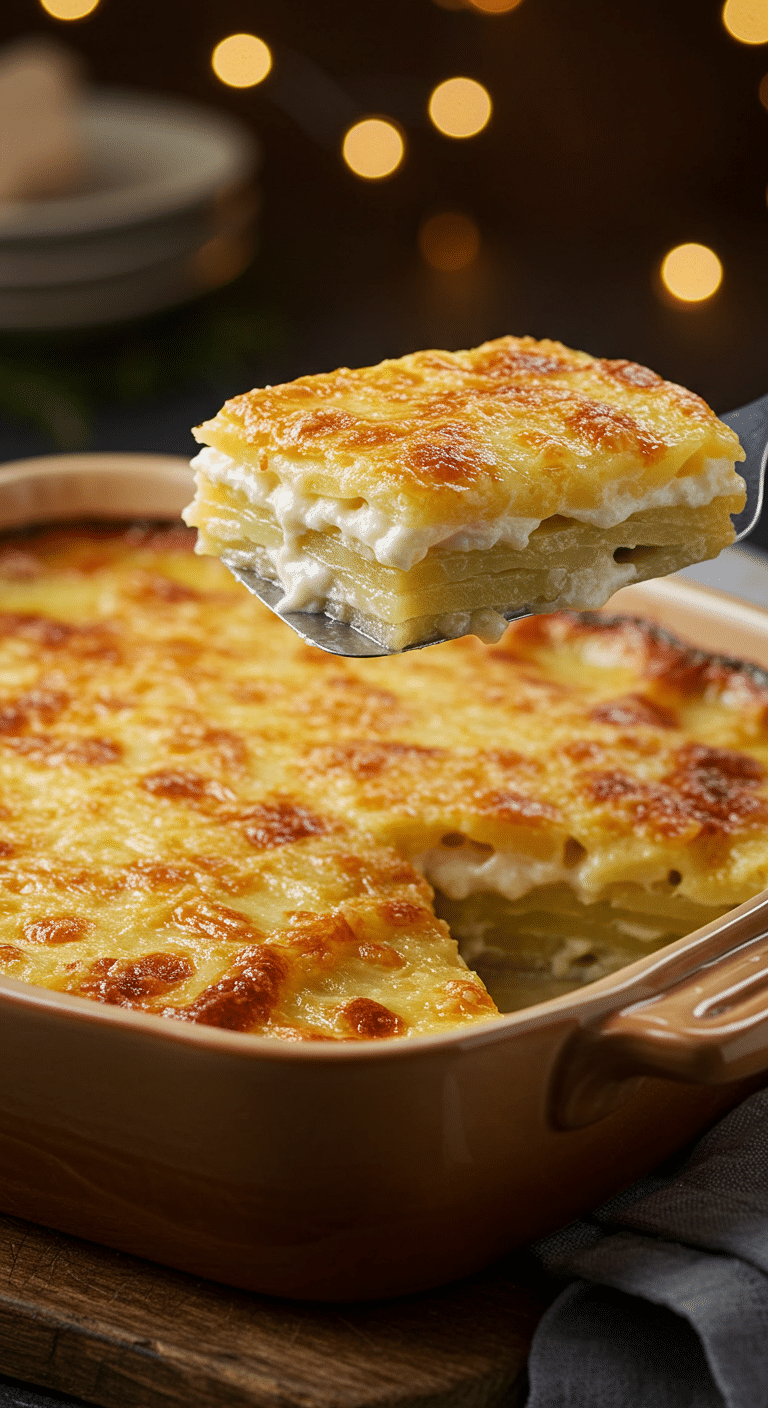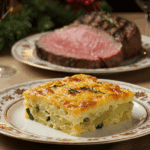Are you ready to master the most elegant, most decadent, and most incredibly delicious potato side dish imaginable? The kind of show-stopping dish that graces the tables of fine dining restaurants, but is secretly simple to create at home? This classic, creamy Scalloped Potato Gratin, with its tender layers of potato baked in a rich, herb-infused cream, is that unforgettable dish.
This isn’t just a recipe; it’s a guide to creating a true culinary masterpiece. Forget watery, bland, or curdled scalloped potatoes. We’ll show you the simple, time-honored secrets—from choosing the right potato to infusing the cream with aromatics—that guarantee a perfect, velvety, and completely foolproof result every single time. This is the ultimate side dish for any holiday feast or special occasion.
Table of Contents
Table of Contents
Recipe Overview: A Taste of Timeless Elegance
What makes this Scalloped Potato Gratin so spectacular is its classic French technique and its focus on simple, high-quality ingredients. This is a true Gratin Dauphinois—a dish where thinly sliced potatoes are slowly baked in a rich, seasoned cream. The starch from the potatoes naturally thickens the cream, creating a luscious, cohesive sauce. The final bake without the foil creates the signature “gratinée,” a beautiful, bubbly, golden-brown crust. It’s a make-ahead marvel that tastes even more luxurious than it looks.
| Metric | Time / Level |
| Total Time | 1 hour 45 minutes (includes resting) |
| Active Prep Time | 20 minutes |
| Difficulty Level | Easy |
| Servings | 6-8 |
The Essential Ingredients for a Perfect Gratin
This recipe uses a handful of classic, high-impact ingredients to create its signature rich and savory flavor.
- The Potatoes (Russets are Key!): The type of potato you use is the most important decision you will make. For the creamiest, most classic gratin, you must use a high-starch potato like a Russet.
- Why Russets?: As the starchy Russet potatoes bake, they release their starches directly into the cream. This is the secret that naturally thickens the sauce, creating a perfectly smooth, velvety, and cohesive result that slices beautifully. Waxy potatoes (like red potatoes) will not thicken the sauce in the same way.
- The Infused Cream: This is where we build a deep, aromatic layer of flavor.
- Heavy Cream: The luxurious, high-fat foundation of our sauce.
- The Aromatics: We gently heat the cream with classic, whole aromatics—bay leaves, fresh thyme sprigs, and chopped garlic—to infuse it with a beautiful, sophisticated flavor that will permeate every layer of the dish.
- The Cheese (Parmesan): In a classic gratin, the cheese is used as a salty, savory seasoning, not a gooey binder. For the best, most authentic nutty flavor, use a high-quality Parmigiano-Reggiano that you grate yourself.
Pro Tutorial: How to Slice Potatoes Perfectly
For the most elegant, beautiful layers, it’s important to slice your potatoes very thinly and uniformly (about 1/8-inch thick). The absolute best tool for this job is an inexpensive mandoline slicer. It’s fast, easy, and guarantees every slice is the perfect thickness. If you don’t have one, just use your sharpest chef’s knife and take your time.

Step-by-Step to the Perfect Potato Gratin
Follow these simple, detailed steps to create this stunning and delicious side dish.
Step 1: Infuse the Cream with Aromatics
First, preheat your oven to 400°F (200°C). Generously butter a 2-quart casserole dish.
In a medium saucepan, combine the 1 1/2 cups of heavy cream, the 3 bay leaves, the 2 sprigs of fresh thyme, the 2 chopped garlic cloves, the 1/2 teaspoon of freshly grated nutmeg, and a generous pinch of salt and pepper.
Heat the cream over medium heat until it is hot and just beginning to simmer around the edges. Do not let it boil. Once it’s simmering, turn off the heat and let the aromatics steep and infuse the cream for about 10-15 minutes.
Step 2: Prepare and Layer the Potatoes
While the cream is infusing, peel your 2 pounds of Russet potatoes and slice them into very thin, 1/8-inch-thick rounds.
Pro Tip: Do not rinse the potato slices after you have cut them! You want to keep all that beautiful surface starch, as it is the secret ingredient that will help to thicken your cream sauce.
Use a slotted spoon to remove and discard the bay leaves and thyme sprigs from the warm cream. Pour the infused cream into a large bowl.
Add the potato slices to the bowl with the cream. Gently mix with your hands or a spatula to coat all the potato slices. Dust the 1/2 cup of grated Parmesan over the potatoes and season the mix with a little more salt and pepper. Gently mix again to incorporate.
Step 3: Assemble and Bake the Gratin
Spoon a little bit of the excess cream from the bottom of the bowl into the bottom of your buttered casserole dish.
Begin to layer the cream-coated potato slices into the dish. You can arrange them in an overlapping, shingled pattern for a beautiful presentation.
Once all the potatoes are in the dish, pour any remaining cream from the bottom of the bowl over the top. Top the gratin with a little more grated Parmesan and a few fresh thyme leaves.
Cover the dish with aluminum foil, but pull back one corner slightly to allow the steam to escape.
Place the dish on a larger, rimmed baking sheet and bake for 40 minutes.
Step 4: The Final Bake for a Golden-Brown Top
After 40 minutes, the potatoes should be getting tender. Carefully remove the foil from the dish.
Sprinkle a little more grated Parmesan cheese evenly over the top.
Return the dish to the oven and continue to bake, uncovered, for another 20 to 30 minutes.
The gratin is perfectly done when the cream has thickened, the potatoes are completely tender, and the top is a beautiful, bubbly, and deep golden brown.
Step 5: The Crucial Rest
Let the finished gratin rest on a wire rack for at least 15 to 20 minutes before serving. This is an absolutely essential step. It allows the hot, bubbly cream and the starches from the potatoes to set up, which is the secret to getting beautiful, clean slices that hold their shape.

The Best Creamy & Classic Scalloped Potato Gratin
A classic and creamy recipe for a scalloped potato gratin. The dish is made with thinly sliced russet potatoes baked in a rich cream sauce. The heavy cream is first infused on the stovetop with aromatics like bay leaves, fresh thyme, and garlic for a deep, savory flavor. The potatoes are tossed with the infused cream and Parmesan cheese, then baked in a casserole dish until tender and bubbly. A final broil creates a golden-brown, cheesy top.
- Prep Time: 20 minutes
- Cook Time: 45 minutes
- Total Time: 1 hour 15 minutes (includes resting time)
- Yield: 6-8 servings
- Category: Side Dish
- Method: Baking, Broiling
- Cuisine: French
- Diet: Vegetarian
Ingredients
- 1 1/2 cups heavy cream
- 3 bay leaves
- 2 sprigs fresh thyme, plus more for garnish
- 2 garlic cloves, chopped
- 1/2 teaspoon freshly grated nutmeg
- Salt and freshly ground black pepper
- Unsalted butter, for the dish
- 2 pounds russet potatoes, peeled and cut into 1/8-inch-thick slices
- 1/2 cup grated Parmesan, plus more for broiling
Instructions
- Preheat the oven to 400°F. Generously butter a casserole dish.
- In a saucepan, heat the heavy cream with the bay leaves, thyme sprigs, chopped garlic, nutmeg, and a pinch of salt and pepper. Bring to a gentle simmer, then remove from heat to infuse.
- While the cream is heating, place the potato slices in a large bowl.
- Using a slotted spoon, remove and discard the bay leaves and thyme sprigs from the cream. Pour the hot, infused cream over the potato slices.
- Add the 1/2 cup of grated Parmesan to the potatoes. Season with a little more salt and pepper and mix gently to coat all the slices.
- Spoon a little of the excess cream from the bottom of the bowl into the buttered casserole dish. Then, spoon the potato mixture into the dish, leveling the top for uniform cooking.
- Pour any remaining cream over the potatoes. Top with some additional Parmesan cheese and fresh thyme leaves.
- Cover the dish with aluminum foil, leaving one corner pulled back to allow steam to escape.
- Bake for 40 minutes.
- (Final step inferred as it was missing from the article) Remove the foil and broil for 3-5 minutes, until the top is golden brown and bubbly. Let rest before serving.
Notes
- Note: The final broiling step was not included in the provided article text but has been inferred based on the ingredients list (‘plus more for broiling’) and standard gratin recipes.
- Infusing the cream with herbs and garlic before adding it to the potatoes is a key step for developing a deep, aromatic flavor.
- Leaving a corner of the foil open allows steam to escape, which helps the gratin to thicken properly instead of becoming watery.
- Russet potatoes are a good choice for this dish as their high starch content helps to thicken the sauce.
Storage and Make-Ahead Tips
This Scalloped Potato Gratin is a fantastic make-ahead side dish for a holiday or dinner party.
- Make-Ahead: You can fully assemble the entire, unbaked gratin up to a day in advance. Let the infused cream cool a bit before you assemble. Cover the unbaked gratin tightly with plastic wrap and store it in the refrigerator. When you are ready to bake, let it sit at room temperature for about 30 minutes, and then bake as directed. You may need to add 15-20 minutes to the initial covered baking time.
- Storage: Store any leftovers, covered, in the refrigerator for up to 5 days.
- Reheating: The best way to reheat the gratin is in a 350°F oven, covered with foil, until it is hot and bubbly. Remove the foil for the last few minutes to re-crisp the top.
For more recipe follow my Pinterest account
Creative Recipe Variations
This classic and elegant recipe is a wonderful base for your own delicious and creative twists.
- Add a Nutty, Cheesy Twist: For a nuttier, even richer flavor that is a classic in many gratins, you can substitute half of the Parmesan cheese with an equal amount of a good quality, freshly grated Gruyère cheese.
- Add a Root Vegetable Layer: For a more complex, earthy flavor, you can swap out about one-third of the potatoes with another thinly sliced root vegetable. Celery root (celeriac) or parsnips are both fantastic choices that pair beautifully with the cream and cheese.
- Add a Crispy Breadcrumb Topping: For some extra textural contrast, you can sprinkle 1/4 cup of panko breadcrumbs over the top of the gratin along with the final layer of Parmesan cheese before the last, uncovered bake.
Enjoy The Ultimate Decadent Side Dish!
You’ve just created a truly special, sophisticated, and deeply comforting side dish that is a cornerstone of classic French and American cuisine. This Scalloped Potato Gratin is a perfect harmony of tender, creamy potatoes, a rich, aromatic sauce, and a crispy, cheesy top. It’s a rewarding and impressive dish that is guaranteed to be the star of any dinner table.
We hope you enjoy every last, rich, and creamy bite!
If you enjoyed making this recipe, please leave a comment below or share it with a friend who loves an elegant potato dish!
Frequently Asked Questions (FAQs)
Q1: What is the difference between scalloped potatoes and potatoes au gratin?
Traditionally, scalloped potatoes are a simpler dish, baked in layers with just cream or milk. A classic potatoes au gratin, like this recipe, is distinguished by the addition of cheese and often a breadcrumb topping, and the term “gratin” refers to the brown, crispy crust that forms on top during baking. However, in modern American cooking, the two names are often used interchangeably.
Q2: What are the best potatoes to use for a gratin?
Q2: What are the best potatoes to use for a gratin? For the creamiest, most classic gratin where the sauce thickens beautifully, you should always use a high-starch potato like a Russet. The starches they release during cooking are what naturally thickens the cream. If you prefer your potato slices to remain very distinct and firm, you can use a waxier potato like a Yukon Gold, but you may need to add a little bit of flour to your cream to help it thicken.
Q3: My cream sauce curdled or looks oily. What happened?
A curdled or broken cream sauce is usually caused by the cream being boiled too aggressively or for too long. In this recipe, we only bring the cream to a gentle simmer to infuse it, and then the oven provides a gentle, even heat that should not cause it to break. Be sure to use a high-fat heavy cream, as lower-fat dairy products are much more likely to curdle.
Q4: Can I make this dish ahead of time for a holiday meal?
Yes, this is an absolutely perfect make-ahead dish! You can fully assemble the entire casserole, cover it, and keep it in the refrigerator for up to 2 days before you plan to bake it. This is a huge time- and stress-saver on a busy cooking day. Just remember to add a little extra time to the bake since it will be starting from cold.
Q5: Why is it so important to let the gratin rest after it comes out of the oven?
This is the most crucial step for a perfect presentation! When the gratin comes out of the oven, the cream sauce is molten hot and very liquid. Letting it rest on the counter for at least 15 to 20 minutes allows the sauce and the starches to cool down slightly and set up. This is the secret that will allow you to cut a beautiful, clean, slice where all the layers hold together perfectly, instead of a runny puddle on the plate.

